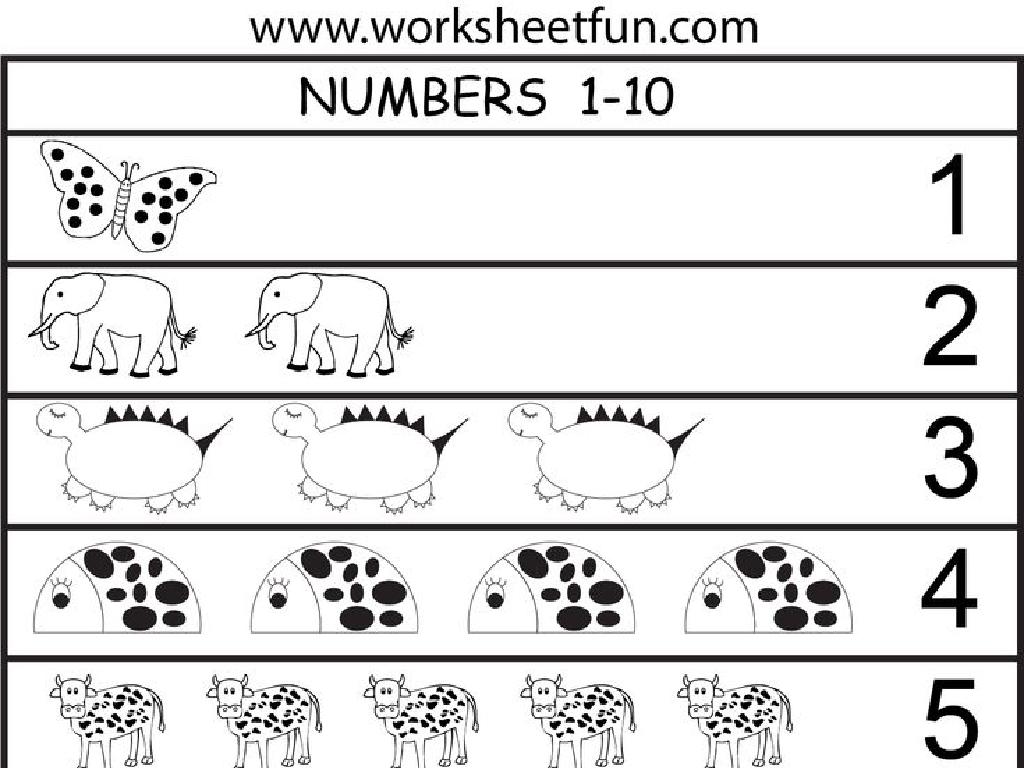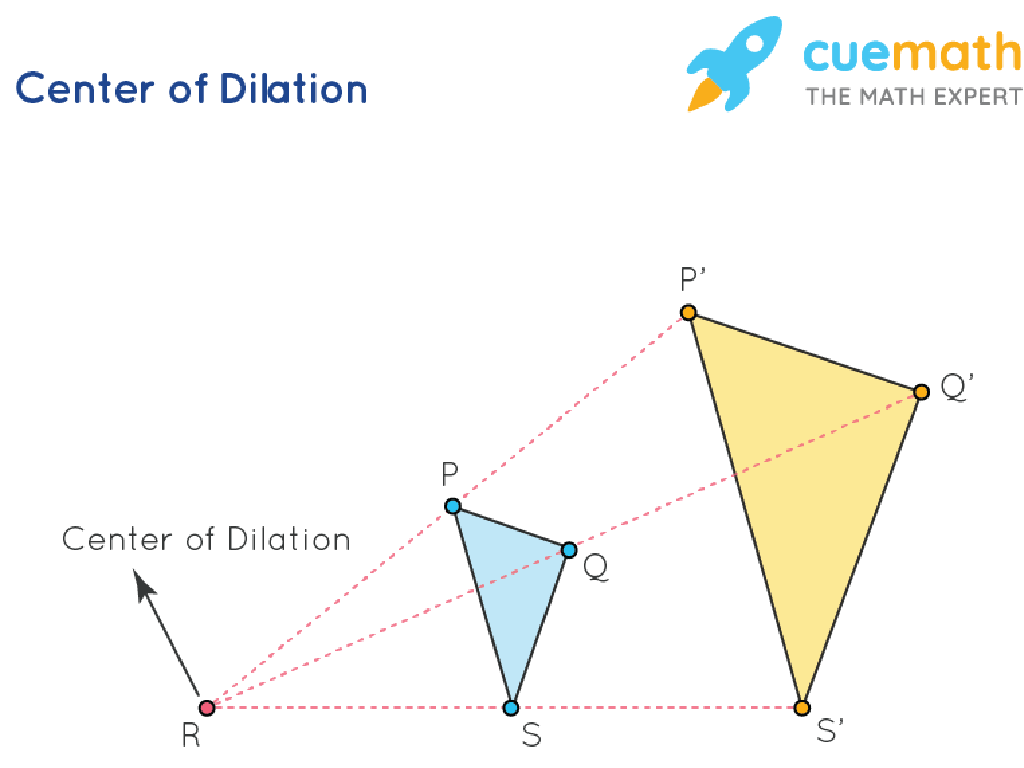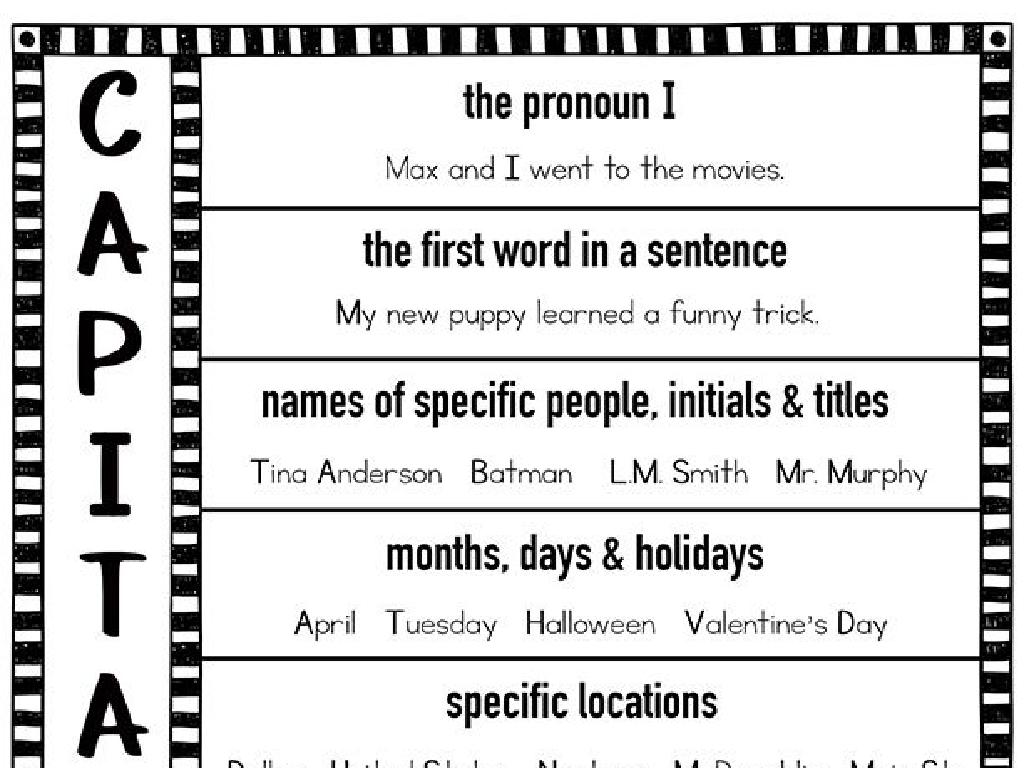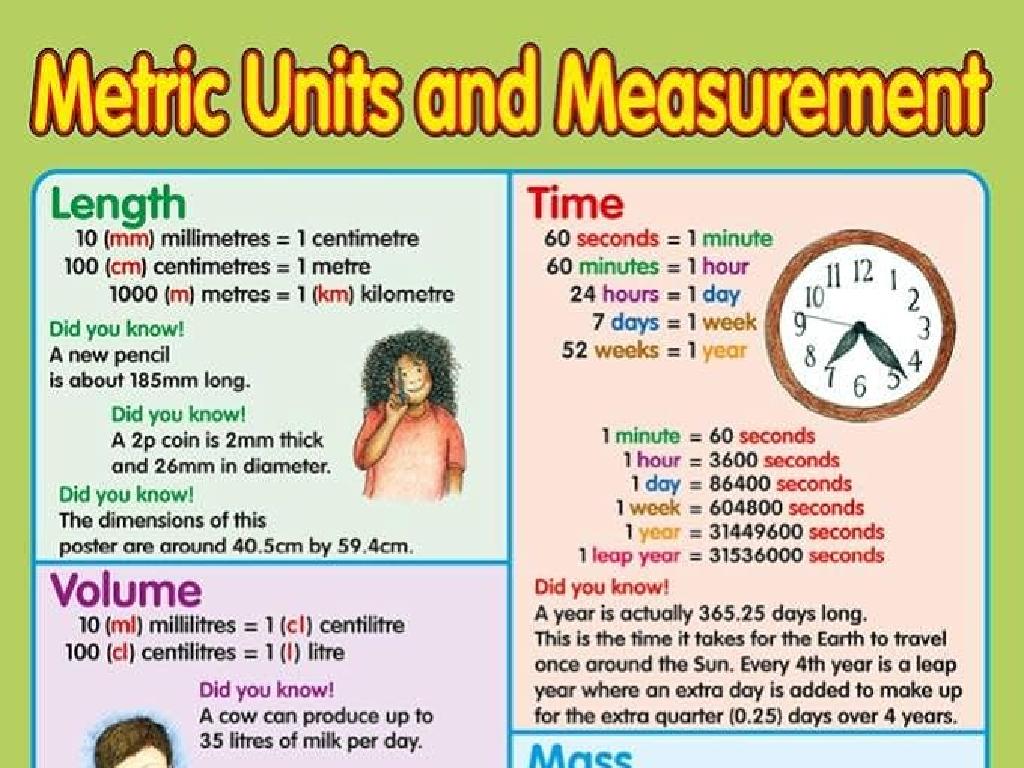One Or More Than One?
Subject: Language arts
Grade: Third grade
Topic: Verb Types
Please LOG IN to download the presentation. Access is available to registered users only.
View More Content
Exploring Verb Types
– Welcome to Language Arts!
– Verbs: Words in action
– Verbs are words like ‘run’, ‘jump’, and ‘think’.
– Verbs show what’s happening
– They tell us the actions of people and things.
– Let’s learn about verbs!
|
This slide introduces the concept of verbs to third-grade students. Begin the lesson by welcoming the students to Language Arts and expressing excitement about today’s topic. Explain that verbs are special words used to describe actions, occurrences, or states of being. They are the words that tell us what someone or something is doing. Use simple and relatable examples like ‘run’, ‘jump’, and ‘think’ to illustrate verbs in action. Encourage the students to come up with their own examples of verbs. This will set the foundation for further exploration into different types of verbs and how they function within sentences.
Understanding Verbs
– Verbs show action or state of being
– Examples: ‘run’, ‘jump’, ‘is’, ‘are’
– Actions: ‘run’, ‘jump’; Being: ‘is’ for one, ‘are’ for many
– Verbs are key in sentences
– Without verbs, sentences have no action or subject state
– Singular vs. Plural verbs
– ‘He runs’ vs. ‘They run’
|
This slide introduces the concept of verbs to third-grade students, emphasizing their role in showing actions or states of being. Use examples like ‘run’ and ‘jump’ for actions, and ‘is’ and ‘are’ to illustrate states of being, highlighting the difference between singular and plural forms. Explain that verbs are crucial for constructing meaningful sentences, as they connect the subject with its action or state. Encourage students to identify verbs in sentences and understand how they change with singular or plural subjects. Activities can include identifying verbs in a story or creating sentences with both singular and plural verbs.
Singular and Plural Nouns
– Reviewing nouns
– Singular noun: just one
– A singular noun means only one item, like ‘dog’.
– Plural noun: more than one
– A plural noun means two or more items, like ‘dogs’.
– Examples: cat vs. cats
– Compare ‘cat’ (one kitty) to ‘cats’ (a bunch of kitties).
|
This slide is meant to refresh the students’ understanding of nouns before introducing verbs. Emphasize the concept of quantity when discussing singular and plural nouns. Singular nouns refer to one single thing, whereas plural nouns indicate multiple things. Use familiar and relatable examples such as pets or toys to illustrate the difference. Encourage the students to look around the classroom and identify singular and plural nouns. This foundational knowledge will help them grasp how verbs change depending on whether they are referring to one thing (singular) or many things (plural).
Singular and Plural Verbs
– Verbs can be singular or plural
– Singular verbs for one person/thing
– ‘Walks’ is singular: The dog walks.
– Plural verbs for many people/things
– ‘Walk’ is plural: The dogs walk.
– Matching verbs with the subject
– Ensure the verb agrees with the subject’s number.
|
This slide introduces the concept of verb agreement in number, which is a fundamental rule in grammar. Singular verbs must be used with singular nouns, and plural verbs are used with plural nouns. It’s crucial for students to understand that the form of the verb changes depending on whether it’s referring to one thing (singular) or more than one thing (plural). Provide examples of both singular and plural verbs and demonstrate how they match with their respective subjects. Encourage students to practice by creating sentences with both singular and plural subjects and selecting the correct verb form to ensure subject-verb agreement.
Matching Verbs with Nouns
– Verbs must agree with nouns
– Singular nouns use singular verbs
– If we say ‘The dog runs’, ‘runs’ is a singular verb for ‘dog’
– Plural nouns use plural verbs
– For ‘The dogs run’, ‘run’ is a plural verb for ‘dogs’
– Practice with examples
– ‘Cat meows’ or ‘Cats meow’? Let’s find out together!
|
This slide is aimed at teaching students the basic rule of subject-verb agreement. It’s crucial for students to understand that verbs must match the number of the noun they are describing. A singular noun, like ‘dog’, will have a verb that does not end in ‘s’, while a plural noun, like ‘dogs’, will have a verb that ends in ‘s’. Use examples that are easy for third graders to understand and relate to. During the presentation, engage the students with interactive examples and ask them to correct sentences with mismatched subjects and verbs. This will help reinforce the concept and ensure they can apply the rule in their writing.
Singular and Plural Verbs
– Singular verb with one cat
– ‘The cat runs fast’ – ‘runs’ is a singular verb
– Plural verb with many cats
– ‘The cats run fast’ – ‘run’ is a plural verb
– Verbs change with the noun number
– Practice makes perfect!
– Let’s find more examples together in class!
|
This slide introduces the concept of verb agreement with singular and plural nouns. Start by explaining that verbs must match the number of the subject (noun). Use the example of ‘cat’ to show how the verb ‘runs’ changes to ‘run’ when the subject becomes plural. Emphasize the importance of using the correct verb form to make sentences clear and correct. Encourage students to look for patterns in verb changes and to practice with different nouns. In the next class, have students come up with their own examples and share them to reinforce the concept.
Let’s Practice: Singular or Plural?
– I say a noun, you identify: singular or plural
– Together, we pick the right verb form
– Why does the verb form matter?
– Verb forms change depending on the noun’s number
– Let’s practice with examples!
– Example: ‘The cat runs.’ vs ‘The cats run.’
|
This interactive slide is for a classroom activity where the teacher will say a noun, and the students will identify if it is singular or plural. Then, as a class, they will choose the correct verb form to match the noun. The teacher should explain that verbs must agree with their subjects in number (singular or plural). This activity helps students understand subject-verb agreement. Prepare a list of nouns beforehand for the activity. Encourage students to explain their reasoning for choosing a particular verb form. This will reinforce their understanding of the concept.
Class Activity: Verb Hunt Adventure
– Let’s go on a verb hunt!
– Find objects and write sentences
– Look around, pick any object like ‘book’ or ‘pencils’
– Use singular and plural verbs
– ‘The book is on the table’ vs. ‘The books are on the table’
– Share with the class
|
This interactive activity is designed to help students understand the difference between singular and plural verbs in a fun and engaging way. Have the students walk around the classroom to find various objects they can write sentences about. Encourage them to use both singular and plural forms of verbs in their sentences. For example, if a student chooses ‘pencil’, they could write ‘The pencil is sharp’ and ‘The pencils are sharp’. After they have written their sentences, ask them to share with the class to reinforce their understanding and to practice speaking skills. As a teacher, be ready to provide guidance and correct any mistakes in verb usage.
Mastering Singular and Plural Verbs
– Celebrating singular and plural verbs
– Verbs show action or state of being
– Like ‘runs’ for one runner or ‘run’ for many
– Match verbs with the noun’s number
– ‘The cat purrs’ but ‘The cats purr’
– Practice makes perfect
– Keep reading and writing to get better!
|
Well done on completing the lesson on singular and plural verbs! It’s important to remember that verbs are the words in a sentence that tell us about an action or a state of being. When using verbs, we must ensure they agree with the subject in number; this means if the subject is singular, the verb must be singular (e.g., ‘The dog barks’), and if the subject is plural, the verb must be plural (e.g., ‘The dogs bark’). Encourage the students to continue practicing by reading books and looking for verb agreement in sentences, as well as by writing their own sentences and stories using singular and plural verbs correctly.






